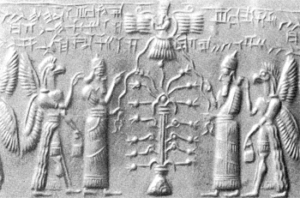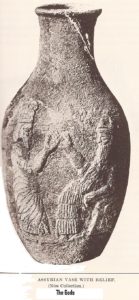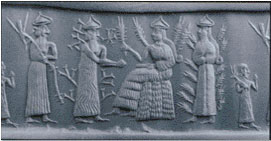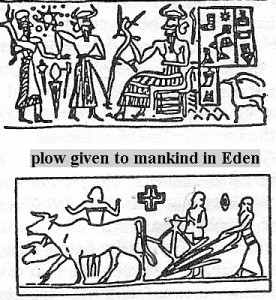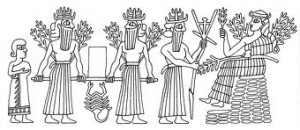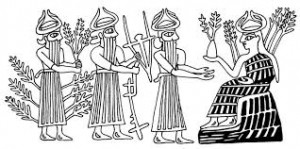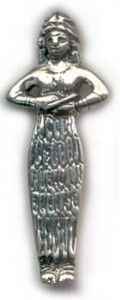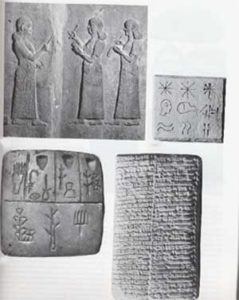http://www.livius.org/li-ln/limmu/limmu_1.html
(Texts: All Artifacts, Color Coding, & Writings in Bold Type With Italics Inside Parenthesis, are Added by Editor R. Brown, not the Authors, Translators, or Publishers!)
(mixed-breed demigods in teal…)
Assyrian Eponym List: list of Assyrian officials (the limmu‘s, or eponymous magistrates) whose names were given to the years. This list was the foundation of the chronology of ancient Assyria, and still is an important tool to reconstruct the chronology. Two parts remain, one dealing with the reigns of king Naram-Sim to king Šamši-Adad I (first quarter of the second millennium) and one dealing with years 858-699.
On this page, you will find the eldest of these fragments, which was publised as text #8 in Jean-Jacques Glassner’s Chroniques Mésopotamiennes (1993; translated as Mesopotamian Chronicles, 2004). There are five copies of this text. The youngest surviving list can be found
|
(c.1876/1875) “From the beginning of the reign of Naram-Sin […] from the eponomy of […] |
|
Šu-Sin. |
|
Aššur-malik. |
|
Aššur-imitti. |
|
Ennam-Sin. |
|
(c.1871/1870) In the eponymy of Akutum, […] took […] Masiam-ili. |
|
Idi-ahum. |
|
(c.1869/1868) In the eponymy of Samanum, Aminum took Šaduppum. |
|
(c.1868/1867) In the eponymy of Illi-ennam, Sin-abum took the land of Sit. |
|
(c.1867/1866) In the eponymy of Ennam-Anum, […]. |
|
(c.1866/1865) In the eponymy of Ennam-Aššur, Ipiq-Adad entered the house of his father. |
|
(c.1865/1864) In the eponymy of Ennam-Sin, […]. |
|
(c.1864/1863) In the eponymy of Hannanarum, Aminum defeated Ipiq-Adad, |
|
(c.1863/1862) In the eponymy of Dadiya, […]. |
|
(c.1862/1861) In the eponymy of Kapatiya, Ipiq-Adad defeated Aminum. |
|
(c.1861/1860) In the eponymy of Išme-Aššur, Ipiq-Adad took Ziqquratum. |
|
(c.1860/1859) In the eponymy of Aššur-muttabbil, Ipiq-Adad […]. |
|
(c.1859/1858) In the eponymy of Šu-Nirah, […]. |
|
(c.1858/1857) In the eponymy of Idi-abum, Sin-abum […]. |
|
(c.1857/1856) In the eponymy of Ili-dan, […]. |
|
Aššur-imitti. |
|
Buzaya. |
|
(c.1854/1853) In the eponymy of Inaia, king Šamši–Adad was born. |
|
(c.1853/1852) In the eponymy of […], a solar eclipse happened; death of Aminum. |
|
[…]-Addu, […]. |
|
Lacuna of about ten years. |
|
(1841/1840) Aššur-malik. |
|
(1840/1839) In the eponymy of Danya, taking of Hupšum. |
|
(1839/1838) In the eponymy of Ennam-Sin, flood in a remote land |
|
Aššur-balati. |
|
Ennam-Aššur. |
|
Itur-Aššur. |
|
(1835/1834) In the eponymy of Šu-bêli, Ila-kabkabu took Suprum. |
|
(1834/1833) In the eponymy of Šarrum-Adad, the man of Elam defeated Ipiq-Adad, and king Šamši–Adad entered the house of his father. |
|
Šu-Laban. |
|
(1832/1831) In the eponymy of Aššur-imitti, the Lullu defeated the king in Lazapatum. |
|
(1831/1830) In the eponymy of Dadaya, Mut-abbih […]. |
|
(1830/1829) In the eponymy of Dadaya, ditto, Ipiq-Adad took Arrapha. |
|
(1829/1828) In the eponymy of Ahi-šalim, the taking of Gasur. |
|
Usur-ša-Ištar, |
|
(1827/1826) In the eponymy of Kataya, […]. |
|
(1826/1825) In the eponymy of Šu-Sin, […]. |
|
(1825/1824) In the eponymy of Abu-šalim, the taking of Sin-abušu of Nerebtum. |
|
(1824/1823) In the eponymy of Šu-Daya, […]. |
|
(1823/1822) In the eponymy of Šu-Dadim, the taking of Ne[…]. |
|
(1822/1821) In the eponymy of Aššur-tukulti, Šamši-Adad defeated the man of Unnini, and Mut-Ia[…] defeated. |
|
(1821/1820) In the eponymy of Puzur-Ištar, Šamši-Adad […]. |
|
(1820/1819) In the eponymy of Atanah, Ipiq-Adad defeated […] and took the land of […]. |
|
(1819/1818) In the eponymy of Erišum, Šamši-Adad defeated […] in Dur-[…]. |
|
Aššur-ennam-šalim. |
|
(1817/1816) In the eponymy of Inib-Ištar, Ipiq-Adad died. |
|
Aššur-Bêl-malki. |
|
(1815/1814) In the eponymy of Be[…], Kirbana […]. |
|
(1814/1813) In the eponymy of […], Šamši-Adad […]. |
|
(1813/1812) In the eponymy of […], Šamši-Adad […]. |
|
(1812/1811) In the eponymy of Šu-ilišu, Šamši-Adad […]. |
|
(1811/1810) In the eponymy of Ibni-Adad, Šamši-Adad [returned from Karduniaš].[1] |
|
Lacuna of two years. |
|
(1808/1807) In the eponymy of Atamar-Ištar, [Šamši-Adad captured Aššur]. |
|
Lacuna of eight years. |
|
(1799/1798) In the eponymy of […]. |
|
(1798/1797) In the eponymy of Idna-Aššur, Šamši-Adad […]. |
|
(1797/1796) In the eponymy of Atanum, Šamši-Adad defeated twelve kings; Iahdun-Lim, king of Mari, […] these kings returned […]. |
|
(1796/1795) In the eponymy of Aššur-taklaku, Šamši-Adad defeated […]. |
|
(1795/1794) In the eponymy of […]. |
|
(1794/1793) In the eponymy of Haya-malik, [Šamši-Adad captured Mari]. |
|
(1793/1792) In the eponymy of Šalim-Aššur, […]. |
|
(1792/1791) In the eponymy of Šalim-Aššur, […]. |
|
(1791/1790) In the eponymy of Ennam-Aššur, Šamši-Adad took the land of […]. |
|
(1790/1789) In the eponymy of Sin-muballit, Šamši-Adad took the land of […]. |
|
(1789/1788) In the eponymy of Riš-Šamaš, Išme-Dagan defeated […]. |
|
(1788/1787) In the eponymy of Ibni-Adad, Šamši-Adad took the land of […]. |
|
(1787/1786) In the eponymy of Aššur-imitti, Šamši-Adad defeated […] and took it. Daduša took the land of […], the land of Me-Turan, the land of […]. |
|
(1786/1785) In the eponymy of Ili-ellati, […]. |
|
(1785/1784) In the eponymy of Rigmanum, Muna[…]. |
|
(1784/1783) In the eponymy of Ikun-piya, Muna[…] defeated […] and Šamši-Adad […] Me-Turan […] for Dadusa […]. |
|
(1783/1782) In the eponymy of Asqudum, Šamši-Adad took Qabra. |
|
(1782/1781) In the eponymy of Aššur-malik, Išme-Dagan defeated Ahazum and Šamši-Adad captured Nurrugum and captured these nine kings: Kibrum, king of […; …, king of …; …, king of …]; Yašub-Adad, king of Ahazum; […, king of …; …, king of …]; Yašub-Lim, king of […; …, king of …, …, king of …]; he gave them as booty to Daduša. |
|
(1781/1780) In the eponymy of Ahiyaya, the Turukkeans opened hostilities. Šamši-Adad and Išme-Dagan defeated the Turukkeans and the […] in Burullan; Yasmah-Adad defeated the Yaminites and unified the banks of the Euphrates. |
|
In the eponymy of Ahiyaya, Mutu-Bisir […] defeated […] at the gate of Saggaratum. |
|
(Colophon) Total […] years, until the victory of the gate of Saggaratum. |
|
Hand of Habdu-malik. Limi-Dagan the nen who dictated.” |
Note 1:
The restoration of this line is based on the Assyrian King List, in which Šamši-Adad’s accession is briefly described (more…).
|
Old Assyrian Period |
||
|
King name |
||
|---|---|---|
|
fl. ca. 1800 BC (short) |
“son of Ilu-shuma“; contemporary of Samu-la-El of Babylonia; said to have built the temple of Ashur |
|
|
(damaged text) |
“son of Ilushuma“ |
|
|
(damaged text) |
“son of Ikunum“ |
|
|
(damaged text) |
“son of Sargon (I)“ |
|
|
(damaged text) |
“son of Puzur-Ashur (II)“ |
|
|
(damaged text) |
“son of Naram-Suen“ |
|
|
fl. ca. 1700 BC (short) |
“son of (local ruler) Ila-kabkabu, went to Karduniash in the time of Naram-Suen. In the eponymy of Ibni-Adad, Shamshi-Adad went up from Karduniash. He took Ekallatum, where he stayed three years. In the eponymy of Atamar-Ishtar, Shamshi-Adad went up from Ekallatum. He ousted Erishum (II), son of Naram-Suen, from the throne and took it.“; He was in turn conquered by Hammurabi of Babylon. |
|
|
(40 years) |
“son of Shamshi-Adad (I)“ |
|
|
(unknown) |
son of Ishme-Dagan I, married to a Hurrian queen; not included in the standard King List, but attested elswhere[11] |
|
|
Remu… |
(unknown) |
included in the alternative King List fragment, last part of name lost; not included in the standard King List[11] |
|
(unknown) |
grandson of Shamshi-Adad I, driven out by vice-regent Puzur-Suen because he was of foreign extraction; not included in the standard King List, but attested in Puzur-Suen’s inscription[11] |
|
|
Seven usurpers: |
||
|
(10 years) |
“son of Adasi“ |
|
|
(17 years) |
“son of Bel-bani“ |
|
|
(12 years) |
“son of Libaya“ |
|
|
(12 years) |
“son of Sharma-Adad (I)“ |
|
|
(28 years) |
“son of Iptar-Suen“ |
|
|
(6 years) |
“son of a nobody“ |
|
|
(14 years) |
“son of Bazaya“ |
|
|
(3 years) |
“son of Shu-Ninua“ |
|
|
(13 years) |
“son of Shu-Ninua“ |
|
|
(6 years) |
“son of Erishum (III)“ |
|
|
(16 years) |
“son of Shamshi-Adad (II)“ |
|
|
(16 years) |
” son of (another) Ishme-Dagan, brother of Sharma-Adad (II), son of Shu-Ninua“ |
|
|
(26 years) |
“son of Ishme-Dagan“ |
|
|
(24 or 14 years) |
“son of Ashur-nirari (I)“; contemporary of Burna-Buriash I of Babylonia[3] |
|
|
(13 years) |
“son of Puzur-Ashur (III)“ |
|
|
(12 years) |
“son Enlil-nasir (I)“ |
|
|
(1 month) |
“son of Nur-ili“ |
|
|
(damaged text) |
“son of Enlil-nasir (I), ousted him (Ashur-shaduni), (and) seized the throne“ |
|
|
(damaged text) |
“son of Ashur-rabi (I)“ |
|
|
ca. 1420–1415 BC (short) |
“his (Ashur-nadin-ahhe I’s) brother, ousted him“ |
|
|
ca. 1414–1408 BC (short) |
“son of Enlil-nasir (II)“ |
|
|
ca. 1407–1399 BC (short) |
“son of Ashur-nirari (II)“ |
|
|
ca. 1398–1391 BC (short) |
“son of Ashur-bel-nisheshu“ |
|
|
ca. 1390–1381 BC (short) |
“son of Ashur-rim-nisheshu“ |
|
Middle Assyrian Period
The dates up to Ninurta-apal-Ekur (ca. 1182–1180 BC) are subject to debate, as some of the regnal lengths vary over the different versions of the King List. The dates given below are based on Assyrian King Lists B and C, which give only three years to Ashur-nadin-apli, and the same to Ninurta-apal-Ekur. (Assyrian King List A gives four years to Ashur-nadin-apli and 13 years to Ninurta-apal-Ekur.[12]) This time frame is also subject to the overall debate about the chronology of the ancient Near East; the short (or low) chronology is used here.
Dates from 1179 to 912 BC, although less secure than dates from 911 BC onwards, are not subject to the chronology debate.[3]
|
Adad-nirari I (ca. 1295–1263 BC) |
||||||
|
Middle Assyrian Period |
||||||
|
King name |
||||||
|---|---|---|---|---|---|---|
|
ca. 1380–1353 BC (short) |
“son of Ashur-bel-nisheshu“ |
|||||
|
ca. 1353–1318 BC (short) |
“son of Eriba-Adad (I)“ |
|||||
|
ca. 1317–1308 BC (short) |
“son of Ashur-uballit“ |
|||||
|
ca. 1307–1296 BC (short) |
“son of Enlil-nirari“ |
|||||
|
ca. 1295–1264 BC (short) |
“son of Arik-den-ili“ |
|||||
|
ca. 1263–1234 BC (short) |
“son of Adad-nirari (I)“ |
|||||
|
ca. 1233–1197 BC (short) |
“son of Shalmaneser (I)“ |
|||||
|
ca. 1196–1194 BC (short) |
“during the lifetime of Tukulti-ninurta (I), Ashur-nadin-apli, his son, seized the throne“ |
|||||
|
ca. 1193–1188 BC (short) |
“son of Ashur-nadin-apli“ |
|||||
|
ca. 1187–1183 BC (short) |
“son of Tukulti-Ninurta (I)“ |
|||||
|
ca. 1182–1180 BC (short) |
“son of Ila-Hadda, a descendant of Eriba-Adad (I), went to Karduniash. He came up from Karduniash (and) seized the throne.“ |
|||||
|
Beginning with Ashur-Dan I, dates are consistent and not subject to middle/short chronology distinctions. |
||||||
|
ca. 1179–1133 BC |
“son of Ashur-nadin-apli“ |
|||||
|
ca. 1133 BC |
“son of Ashur-dan (I), briefly“ |
|||||
|
ca. 1133 BC |
“his (Ninurta-tukulti-Ashur’s) brother, fought him and took him to Karduniash. Mutakkil-Nusku held the throne briefly, then died.“ |
|||||
|
ca. 1133–1115 BC |
“son of Mutakkil-Nusku“ |
|||||
|
ca. 1115–1076 BC |
“son of Ashur-resh-ishi (I)“ |
|||||
|
ca. 1076–1074 BC |
“son of Tiglath-pileser (I)“ |
|||||
|
ca. 1074–1056 BC |
“son of Tiglath-pileser (I)“ |
|||||
|
ca. 1056–1054 BC |
“son of Ashur-bel-kala“ |
|||||
|
ca. 1054–1050 BC |
“son of Tiglath-pileser (I), came up from Karduniash. He ousted Eriba-Adad (II), son of Ashur-bel-kala, (and) seized the throne“ |
|||||
|
ca. 1050–1031 BC |
“son of Shamshi-Adad (IV)“ |
|||||
|
ca. 1031–1019 BC |
“son of Ashur-nasir-pal (I)“ |
|||||
|
ca. 1019–1013 BC |
“son of Shalmaneser (II)“ |
|||||
|
ca. 1013–972 BC |
“son of Ashur-nasir-pal (I)“ |
|||||
|
ca. 972–967 BC |
“son of Ashur-rabi (II)“ |
|||||
|
ca. 967–935 BC |
“son of Ashur-resh-ishi (II)“ |
|||||
|
ca. 935–912 BC |
“son of Tiglath-Pileser (II)“ |
|||||
Neo-Assyrian Period
|
Neo-Assyrian Empire (824 & 671 BC) |
|
Tiglath-Pileser III (745–727 BC) |
|
Ashurbanipal (669–631 BC) |
Synchronisms between the limmu lists and absolute dates known from Babylonian chronology provide good absolute dates for the years between 911 BC and 649 BC.
The dates for the very end of the Assyrian period are uncertain due to the lack of limmu lists after 649 BC. Some sources list Ashurbanipal‘s death in 631 BC, rather than 627 BC; Ashur-etil-ilani then reigns from 631 to 627, and Sin-shar-ishkun reigns until 612 BC, when he is known to have died in the sack of Nineveh.[3]
|
Neo-Assyrian Period |
|||
|
King name |
|||
|---|---|---|---|
|
912–891 BC |
“son of Ashur-Dan (II)“ |
||
|
891–884 BC |
“son of Adad-nirari (II)“ |
||
|
884–859 BC |
“son of Tukulti-Ninurta (II)“ |
||
|
859–824 BC |
“son of Ashur-nasir-pal (II)“ |
||
|
824–811 BC |
“son of Shalmaneser (III)“ |
||
|
Shammu-ramat, regent, 811–808 BC |
|||
|
811–783 BC |
“son of Shamshi-Adad (V)“ |
||
|
783–773 BC |
“son of Adad-nirari (III)“ |
||
|
773–755 BC |
“son of Shalmaneser (IV)“; solar eclipse 763 BC[3] |
||
|
755–745 BC |
“son of Adad-nirari (III)“ |
||
|
745–727 BC |
“son of Ashur-nirari (V)“ |
||
|
727–722 BC |
“son of Tiglath-Pileser (III)“ |
||
|
End of the document known as Assyrian King List; the following kings reigned after the list had been composed. |
|||
|
722–705 BC |
co-regency with Shalmaneser V from 722–709 BC |
||
|
705–681 BC |
|||
|
681–669 BC |
|||
|
The dates of the last kings are not certain. |
|||
|
669–between 631 and 627 BC |
|||
|
ca. 631–627 BC |
|||
|
626 BC |
|||
|
ca. 627–612 BC |
|||
|
In 612 BC, Nineveh, the Assyrian capital, fell to the Medes and Babylonians; supported by the Egyptians, an Assyrian general continued to rule for a few years from Harran. |
|||
|
612 BC–ca. 609 BC |
Harran defeated by Nabopolassar of Babylonia |
||
Assyrian Eponym List (2/1)

King Sargon II (right) and his crown prince Sennacherib (left) on a relief from Khorsabad, now in the Louvre, Paris. Assyrian Eponym List: list Assyrian officials (the limmu‘s, or eponymous magistrates) whose names were given to the years. This list was the foundation of the chronology of ancient Assyria, and still is an important tool to reconstruct the chronology. Two parts remain, one dealing with the first quarter of the second millennium and one dealing with years 858-699.
On this page, you will find the first part of the youngest of these fragments, which was publised as text #9 in Jean-Jacques Glassner’s Chroniques Mésopotamiennes (1993; translated as Mesopotamian Chronicles, 2004). There are ten copies of this text, found in Nineveh, Sultan-Tepe, and Aššur.The other surviving Eponym List can be found here.
|
(…) reign of Šalmaneser [III] son of Aššurnasirpal [II], king of Assyria. |
|
—————————————— |
|
[858/857] During the eponymy of Šarru-baltu-niši, campaign against […]. |
|
[857/856] During the eponymy of Šalmaneser, the king of Assyria, campaign against […]. |
|
[856/855] During the eponymy of Aššur-bêla-ka’in, the commander in chief, campaign against […]. |
|
[855/854] During the eponymy of Aššur-bunaya-usur, the chief buttler, campaign against […] |
|
[854/853] During the eponymy of Abi-ina-ekalli-lilbur, the palace herald […]. |
|
[853/852] During the eponymy of Dayan-Aššur, the commander in chief, […] |
|
[852/851] During the eponymy of Šamaš-abua, governor of Nisibis, […]. |
|
[851/850] During the eponymy of Šamaš-bêla-usur, governor of Kalhu, […]. |
|
[850/849] During the eponymy o Bêl-bunaya, the palace herald, […]. |
|
[849/848] During the eponymy of Hadi-lipušu, governor of Na’iri, […]. |
|
[848/847] During the eponymy of Nergal-alik-pani, governor of […]. |
|
[847/846] During the eponymy of Bur-ramman, governor of […]. |
|
[846/845] During the eponymy of Inurta-mukin-niši, the palace herald, […]. |
|
[845/844] During the eponymy of Inurta-nadin-šumi, governor of […]. |
|
[844/843] During the eponymy of Aššur-bunaya, governor of […]. |
|
[843/842] During the eponymy of Tab-Inurta, governor of […]. |
|
[842/841] During the eponymy of Taklak-ana-šarri, governor of Nemed-Ištar, […]. |
|
[841/840] During the eponymy of Addad-remannii, governor of Guzana, […]. |
|
[840/839] During the eponymy of Šamaš-abua, governor of Rasappa, campaign against the cedar mountain. |
|
[839/838] During the eponymy of Šulma-bêli-lamur, governor of Ahuzuhina, campaign against Qu’e [Cilicia]. |
|
[838/837] During the eponymy of Inurta-kibsi-usur, governor of Rasappa, campaign against Malahi. |
|
[837/836] During the eponymy of Inurta-ilaya, governor of Ahizuhina, campaign against Danabu. |
|
[836/835] During the eponymy of Qurdi-Aššur, governor of Raqmat, campaign […]. |
|
[835/834] During the eponymy of Šep-šarri, governor of Habruri, campaign against Milidu. |
|
[834/833] During the eponymy of Nergal-mudammiq, governor of Nineveh, campaign against Namri. |
|
[833/832] During the eponymy of Yahulu, the chamberlain, campaign against Qu’e. |
|
[832/831] During the eponymy of Ululayu, governor of Kalizi, campaign against Qu’e. |
|
[831/830] During the eponymy of Šarru-hatta-ipe, governor of […], campaign agains Qu’e; [the god] Anu the Great left Der. |
|
[830/829] During the eponymy of Nergal-ilaya, governor of Isana, campaign against Urartu. |
|
[829/828] During the eponymy of Hubaya, governor of […]hi, campaign against Unqu. |
|
[828/827] During the eponymy of Ilu-mukin-ahi, governor of […]ha, campaign against Ulluba. |
|
—————————————— |
|
[827/826] During the eponymy of Šalmaneser, the king of Assyria, campaign against Mannea. |
|
[826/825] During the eponymy of Dayan-Aššur, the commander in chief, revolt. |
|
[825/824] During the eponymy of Aššur-bunaya-usur, the great butler, revolt. |
|
[824/823] During the eponymy of Yahalu, the commander in chief, revolt. |
|
[823/822] During the eponymy of Bêl-bunaya, the palace herald, revolt. |
|
—————————————— |
|
Thirty-five years, Šalmaneser, king of Assyria. |
|
—————————————— |
|
[822/821] During the eponymy of Šamši-Adad [V], the king of Assyria, revolt. |
|
[821/820] During the eponymy of Yahalu, the commander in chief, revolt. |
|
[820/819] During the eponymy of Bêl-dan, the palace herald, the revolt was suppressed. |
|
[819/818] During the eponymy of Inurta-ubla, governor of […], campaign against Mannea. |
|
[818/817] During the eponymy of Šamaš-ilaya, governor of […], campaign against […]šumme. |
|
[817/816] During the eponymy of Nergal-ilaya, governor of Isana, campaign against Tille. |
|
[816/815] During the eponymy of Aššur-bunaya-usur, the chief butler, campaign against Tille. |
|
[815/814] During the eponymy of Šarru-hattu-ilpe, governor of Nisibis, campaign against Zaratu. |
|
[814/813] During the eponymy of Bêl-lu-ballat, the commander in chief, campaign against Der; Anu the Great went to Der. |
|
[813/812] During the eponymy of Mušekniš, governor of Habruri, campaign against Ahsana. |
|
[812/811] During the eponymy of Inurta-ašared, governor of Raqmat, campaign against Chaldaea. |
|
[811/810] During the eponymy of Šamaš-kumua, governor of Arrapha, campaign against Babylon. |
|
[810/809] During the eponymy of Bêl-qate-sabat, governor of Mazamua, the king stayed in the land. |
|
—————————————— |
|
Thirteen years, Šamši-Adad, king of Assyria. |
|
—————————————— |
|
[809/808] During the eponymy of Adad-Nirari [III], the king of Assyria, campaign against Media. |
|
[808/807] During the eponymy of Nergal-ilaya, the commander in chief, campaign against Guzana. |
|
[807/806] During the eponymy of Bêl-dân, the palace herald, campaign against Mannea. |
|
[806/805] During the eponymy of Sil-Bêli, the chief butler, campaign against Mannea. |
|
[805/804] During the eponymy of Aššur-taklak, the chamberlain, campaign against Arpad. |
|
[804/803] During the eponymy of Ilu-issiya, governor of Aššur, campaign against Hazazu. |
|
[803/802] During the eponymy of Nergal-ereš, governor of Rasappa, campaign against Ba’alu. |
|
[802/801] During the eponymy of Aššur-balti-ekurri, governor of Arrapha, campaign against the Sealand; plague. |
|
[801/800] During the eponymy of Inurta-ilaya, governor of Ahizuhina, campaign against Hubuškia. |
|
[800/799] During the eponymy of Šep-Ištar, governor of Nisibis, campaign against Media. |
On this page, you will find the second part of the youngest of these fragments, which was publised as text #9 in Jean-Jacques Glassner’s Chroniques Mésopotamiennes (1993; translated as Mesopotamian Chronicles, 2004). There are ten copies of this text, found in Nineveh, Sultan-Tepe, and Aššur.
|
[800/799] During the eponymy of Šep-Ištar, governor of Nisibis, campaign against Media. |
|
[799/798] During the eponymy of Marduk-išmanni, governor of Amedi, campaign against Media. |
|
[798/797] During the eponymy of Mutakkil-Marduk, the chief eunuch, campaign against Lušia. |
|
[797/796] During the eponymy of Bêl-tarsi-iluma, governor of Kalhu, campaign against Namri. |
|
[796/795] During the eponymy of Aššur-bêla-usur, governor of Habruri, campaign against Manduate. |
|
[795/794] During the eponymy of Marduk-šaduni, governor of Raqmat, campaign against Der. |
|
[794/793] During the eponymy of Kinu-abua, governor of Tušhan, campaign against Der. |
|
[793/792] During the eponymy of Mannu-ki-Aššur, governor of Guzana, campaign against Media. |
|
[792/791] During the eponymy of Mušallim-Inurta, governor of Tille, campaign against Media. |
|
[791/790] During the eponymy of Bêl-iqišanni, governor of Šibhiniš, campaign against Hubuškia. |
|
[790/789] During the eponymy of Šep-Šamaš, governor of Isana, campaign against Itu’a. |
|
[789/788] During the eponymy of Inurta-mukin-ahi, governor of Nineveh, campaign against Media. |
|
[788/787] During the eponymy of Adad-mušammer, governor of Kalizi, campaign against Mdia; foundations of the temple of Nabû in Nineveh laid. |
|
[787/786] During the eponymy of Sil-Ištar, governor of Arbela, campaign against Media; Nabû entered his new temple. |
|
[786/785] During the eponymy of Nabû-šarra-usur, governor of Talmusu, campaign against Kisku. |
|
[785/784] During the eponymy of Adad-uballit, governor of Tamnuna, campaign against Hubuškia; [the god] Anu the Great went to Der. |
|
[784/783] During the eponymy of Marduk-šarra-usur, governor of Arbela, campaign against Hubuškia. |
|
[783/782] During the eponymy of Inurta-nasir, governor of Mazamua, campaign against Itu’a. |
|
[782/781] During the eponymy of Iluma-le’i, governor of Nisibis, campaign against Itu’a. |
|
—————————————— |
|
Twenty-eight years, Adad-nirari [III], king of Assyria. |
|
—————————————— |
|
[781/780] During the eponymy of Šalmaneser [IV], the king of Assyria, campaign against Urartu. |
|
[780/779] During the eponymy of Šamši-ilu, the commander in chief, campaign against Urartu. |
|
[779/778] During the eponymy of Marduk-remanni, the chief butler, campaign against Urartu. |
|
[778/777] During the eponymy of Bêl-lešer, the palace herald, campaign against Urartu. |
|
[777/776] During the eponymy of Nabû-išdeya-ka’in, the chamberlain, campaign against Itu’a. |
|
[776/775] During the eponymy of Pan-Aššur-lamur, governor of Aššur, campaign against Urartu. |
|
[775/774] During the eponymy of Nergal-ereš, governor of Rasappa, campaign against the cedar mountain. |
|
[774/773] During the eponymy of Ištar-duri, governor of Nisibis, campaign against Urartu and Namri |
|
[773/772] During the eponymy of Mannu-ki-Adad, governor of Raqmat, campaign against Damascus. |
|
[772/771] During the eponymy of Aššur-bela-usur, governor of Kalhu, campaign against Hatarikka. |
|
—————————————— |
|
Ten years, Šalmaneser, king of Assyria. |
|
—————————————— |
|
[771/770] During the eponymy of Aššur-dan [III], king of Assyria, campaign against Gananati. |
|
[770/769] During the eponymy of Šamši-ilu, the commander in chief, campaign against Marad. |
|
[769/768] During the eponymy of Bêl-ilaya, governor of Arrapha, campaign against Itu’a. |
|
[768/767] During the eponymy of Aplaya, governor of Mazamua, the king stayed in the land. |
|
[767/766] During the eponymy of Qurdi-Aššur, governor of Ahizuhina, campaign against Gananati. |
|
[766/765] During the eponymy of Mušallim-Inurta, governor of Tille, campaign against Media. |
|
[765/764] During the eponymy of Inurta-mukin-niši, governor of Habruri, campaign against Hatarikka; plague. |
|
[764/763] During the eponymy of Sidqi-ilu, governor of Tušhan, the king stayed in the land. |
|
—————————————— |
|
[763/762] During the eponymy of Bur-Saggile, governor of Guzana, revolt in Libbi-ali; in Simanu eclipse of the sun [15 June 763]. |
|
[762/761] During the eponymy of Tab-bêlu, governor of Amedi, revolt in Libbi-ali. |
|
[761/760] During the eponymy of Nabû-mukin-apli, governor of Nineveh, revolt in Arrapha. |
|
[760/759] During the eponymy of La-qipu, governor of Kalizi, revolt in Arrapha. |
|
[759/758] During the eponymy of Pan-Aššur-lamur, governor of Arbela, revolt in Guzana; plague. |
|
[758/757] During the eponymy of Ana-bêli-taklak, governor of Isana, campaign against Guazana; peace in the land. |
|
[757/756] During the eponymy of Inurta-iddin, governor of Kurba’il, the king stayed in the land. |
|
[756/755] During the eponymy of Bêl-šadua, governor of Tamnuna, the king stayed in the land. |
|
[755/754] During the eponymy of Iqisu, governor of Šibhiniš, campaign against Hatarikka. |
|
[754/753] During the eponymy of Inurta-šezibanni, governor of Talmusu, campaign against Arpad; return from Aššur. |
|
—————————————— |
|
[753/752] During the eponymy of Aššur-nirari [V], king of Assyria, the king stayed in the land. |
|
[752/751] During the eponymy of Šamši-ilu, the commander in chief, the king stayed in the land. |
|
[751/750] During the eponymy of Marduk-šallimanni, the palace herald, the king stayed in the land. |
|
[750/749] During the eponymy of Bêl-dan, the chief butler, the king stayed in the land. |
On this page, you will find the third part of the youngest of these fragments, which was publised as text #9 in Jean-Jacques Glassner’s Chroniques Mésopotamiennes (1993; translated as Mesopotamian Chronicles, 2004). There are ten copies of this text, found in Nineveh, Sultan-Tepe, and Aššur.The first part can be found here, and the other surviving Eponym List can be found here.
|
[750/749] During the eponymy of Bêl-dan, the chief butler, the king stayed in the land. |
|
[749/748] During the eponomy of Šamaš-kenu-dugul, the chamberlain, campaign against Namri. |
|
[748/747] During the eponomy of Adad-bela-ka’in, the governor of Aššur, campaign against Namri. |
|
[747/746] During the eponomy of Sin-šallimanni, the governor of Rasappa, the king stayed in the land. |
|
[746/745] During the eponomy of Nergal-nasir, the governor of Nisibis, revolt in Kalhu. |
|
—————————————— |
|
[745/744] During the eponomy of Nabû-bela-usur, the governor of Arrapha, in Ajaru, the thirteenth, Tiglath-pileser [III] ascended the throne. In Tašrîtu, he on Mesopotamia.[1] |
|
[744/743] During the eponomy of Bêl-dan, the governor of Kalhu, campaign against Namri. |
|
[743/742] During the eponomy of Tiglath-pileser, the king of Assyria, there was a massacre among the Urartaeans in Arpad. |
|
[742/741] During the eponomy of Nabû-da’inannil, the commander in chief, campaign against Arpad. |
|
[741/740]During the eponomy of Bêl-Harran-bêla-usur, the palace herald, campaign against the same; the city was taken after three years. |
|
[740/739] During the eponomy of Nabû-etiranni, the chief butler, campaign against Arpad. |
|
[739/738] During the eponomy of Sin-taklak, the chamberlain, campaign against Ulluba; Birtu was captured |
|
[738/737] During the eponomy of Adad-bêla-ka’in, the governor of Aššur, Kullania was captured. |
|
[737/736] During the eponomy of Bêl-emuranni, the governor of Rasappa, campaign against Media. |
|
[736/735] During the eponomy of Inurta-ilaya, the governor of Nisibis, campaign at the foot of Mount Nal. |
|
[735/734] During the eponomy of Aššur-šallimanni, the governor of Arrapha, campaign against Urartu. |
|
[734/733] During the eponomy of Bêl-dan, the governor of Kalhu, campaign against Philistia.[2] |
|
[733/732] During the eponomy of Aššur-da’inanni, the governor of Mazamua, campaign against Damascus. |
|
[732/731] During the eponomy of Nabû-bêla-usur, the governor of Si’imme, campaign against Damascus. |
|
[731/730] During the eponomy of Nergal-uballit, the governor of Ahizu-hina, campaign against Šapiya. |
|
[730/729] During the eponomy of Bêl-lu-dari, the governor of Tille, the king stayed in the land. |
|
[729/728] During the eponomy of Liphur-ilu, the governor of Habruri, the king took the hand of Bêl [and became king of Babylonia]. |
|
[728/727]During the eponomy of Dur-Aššur, the governor of Tušhan, the king took the hand of Bêl; the city of Hi[…] was captured. |
|
—————————————— |
|
[727/726] During the eponomy of Bêl-Harran-bêla-usur, the governor of Guzana, campaign against […]. Šalmaneser [V] ascended the throne. |
|
[726/725] During the eponomy of Marduk-bêla-usur, the governor of Amedi, the king stayed in the land. |
|
[725/724] During the eponomy of Mahde, the governor of Nineveh, campaign against […]. |
|
[724/723] During the eponomy of Aššur-išmanni, the governor of Kalizi, campaign against […]. |
|
[723/722] During the eponomy of Šalmaneser, the king of Assyria, campaign against […]. |
|
[722/721] During the eponomy of Inurta-ilaya, the commander in chief. |
|
[721/720] During the eponomy of Nabû-taris, the governor of […]ti. |
|
[720/719] During the eponomy of Aššur-nirka-da’in, the governor of […]ru. |
|
[719/718] During the eponomy of Sargon [II], the king of Assyria entered […]. |
|
[718/717] During the eponomy of Zeru-ibni, the governor of Rasappa, campaign against Tabal. |
|
[717/716] During the eponomy of Tab-šar-Aššur, the chamberlain, Dur-Šarruken [the new capital of Assyria] was founded. |
|
[716/715] During the eponomy of Tab-sil-Ešarra, the governor of Libbi-ali, campaign against Mannea. |
|
[715/714] During the eponomy of Taklak-ana-bêli, the governor of Nisibis, governors were appointed. |
|
[714/713] During the eponomy of Ištar-duri, the governor of Arrapha, campaign against Urartu and Musasi; [the statue of the god] Haldi was deported. |
|
[713/712]During the eponomy of Aššur-bani, the governor of Kalhu, the nobles fought at Ellipi; the god […] entered his new temple, to Musasir. |
|
[712/711] During the eponomy of šarru-emuranni, the governor of Mazamua,the king stayed in the land. |
|
[711/710] During the eponomy of Inurta-alik-pani, the governor of Si’immel, campaign against Mar’aš. |
|
[710/709] During the eponomy of Šamaš-bêla-usur, the governor of Ahizuhina, campaign against Bit-zeri [against the Babylonian ruler Marduk-apla-iddina, who was defeated]; the king stayed in Kiš. |
|
[709/708] During the eponomy of Mannu-ki-Aššur-le’i, the governor of Tille, Sargon took the hand of Bêl [and became king of Babylonia]. |
|
[708/707] During the eponomy of Šamaš-upahhir, the governor of Habruri, Kummuhu was captured; a governor was appointed. |
|
[707/706] During the eponomy of Ša-Aššur-dubbu, the governor of Tušhan, the king returned from Babylon; the chief vizier, the nobles, the booty of Dur-Yakin was carried off; […] Dur-Yakin was destroyed; in Tašrîtu, the twenty-second, the gods of Dur-Šarruken entered their temples. |
|
[706/705]During the eponomy of Mutakkil-Aššur, the governor of Guzana, the king stayed in the land; the nobles were in Karalla; in Ajaru, the sixth, Dur-Šarruken was completed; […] received. |
|
—————————————— |
|
[705/704]During the eponomy of Nashru-Bêl, the governor of Amedi, the king marched on Tabal; against Gurdi, the Kulummaean, […] the king was killed; the camp of the king of Assyria […] In Abu, the twelfth, Sennacherib, the king [started his reign?]. |
|
[704/703]During the eponomy of Nabû-deni-epuš, the governor of Nineveh, to Larak and Sarrabanu; the palace of Kalizi was restored, in […] the nobles afainst the Kulummaean. |
|
[703/702] During the eponomy of Nuhšaya, the governor of Kalizi, campaign against [Babylonia?]. |
|
[702/701] During the eponomy of Nabû-le’i, the governor of Arbela, campaign against [Hirimma and Hararatum?]. |
|
[701/700] During the eponomy of Hananu, the governor of Til-Barsip, […] from Halzi […] |
|
[700/699] During the eponomy of Metunu, the governor of Isana, Aššur-nadin-šumi, the son of Sennacherib, [became king of Babylonia?] of the palace, in the city […], great cedar logs, alabaster in Ammananum […], in Kapri-Dagili […] for […] the king […]. |
|
[699/698] During the eponymy of Bêl-šarrani, governor of Kurba’il, |
|
Broken off |
Note 1:
This campaign is described in ABC 1, a chronicle that describes the period from Nabu-Nasir to Šamaš-šuma-ukin.
Note 2:
In Israel, king Pekah was defeated, lost a large part of his kingdom, and was replaced by Hoshea (2 Kings 15.29).







